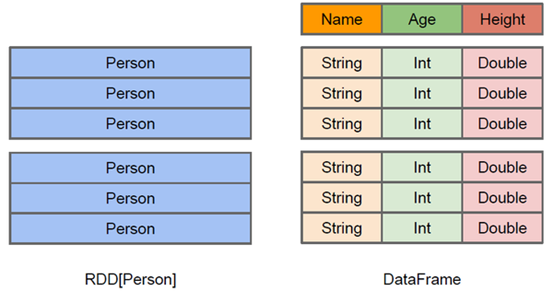SparkSql學習筆記(包含IDEA編寫的原生代碼)
Spark SQL and DataFrame
1.為什麼要用Spark Sql
原來我們使用Hive,是將Hive Sql 轉換成Map Reduce 然後提交到叢集上去執行,大大簡化了編寫MapReduce的程式的複雜性,由於MapReduce這種計算模型執行效率比較慢,所以Spark Sql的應運而生,它是將SparkSql轉換成RDD,然後提交到叢集執行,執行效率非常的快。
Spark Sql的有點:1、易整合 2、統一的資料訪問方式 3、相容Hvie 4、標準的資料連線
2、DataFrames
什麼是DataFrames?
與RDD類似,DataFrames也是一個分散式資料容器,然而DataFrame更像是傳統資料庫的二維表格,除了資料以外,還記錄資料的結構資訊,即schema。同時,與Hive類似,DataFrame與支援巢狀資料型別(struct、array和map)。從API的易用性上看,DataFrame API提供的是一套高層的關係操作,比函式式的RDD API要更加友好,門檻更低。由於與R和Pandas的DataFrame類似,Spark DataFrame很好地繼承了傳統單機資料分析的開發體驗。

建立DataFrames
在Spark SQL中SQLContext是建立DataFrames和執行SQL的入口,在spark-1。5.2中已經內建了一個sqlContext。
1.在本地建立一個檔案,有三列,分別是id、name、age,用空格分隔,然後上傳到hdfs上
hdfs dfs -put person.txt /
2.在spark shell執行下面命令,讀取資料,將每一行的資料使用列分隔符分割
val lineRDD = sc.textFile("hdfs://hadoop01:9000/person.txt").map(_.split(" "))
3.定義case class(相當於表的schema)
case class Person(id:Int, name:String, age:Int)
4.將RDD和case class關聯
val personRDD = lineRDD.map(x => Person(x(0).toInt, x(1), x(2).toInt))
5.將RDD轉換成DataFrame
val personDF = personRDD.toDF
6.對DataFrame進行處理
personDF.show
程式碼:
object SparkSqlTest {
def main(args: Array[String]): Unit = {
val conf = new SparkConf().setMaster("local").setAppName("SQL-1")
val sc = new SparkContext(conf)
fun1(sc)
}
//定義case class 相當於表的schema
case class Person(id:Int,name:String,age:Int)
def fun1(sc:SparkContext): Unit ={
val sqlContext = new SQLContext(sc)
// 位置一般情況下是換成HDFS檔案路徑
val lineRdd = sc.textFile("D:\\data\\person.txt").map(_.split(" "))
val personRdd = lineRdd.map(x=>Person(x(0).toInt,x(1),x(2).toInt))
import sqlContext.implicits._
val personDF = personRdd.toDF
//登錄檔
personDF.registerTempTable("person_df")
//傳入sql
val df = sqlContext.sql("select * from person_df order by age desc")
//將結果以JSON的方式儲存到指定位置
df.write.json("D:\\data\\personOut")
sc.stop()
}
DataFrame 常用操作
DSL風格語法(個人理解短小精悍的含義)
// 檢視DataFrame部分列中的內容
df.select(personDF.col("name")).show()
df.select(col = "age").show()
df.select("id").show()
// 列印DataFrame的Schema資訊
df.printSchema()
//查詢所有的name 和 age ,並將 age+2
df.select(df("id"),df("name"),df("age")+2).show()
//查詢所有年齡大於20的
df.filter(df("age")>20).show()
// 按年齡分組並統計相同年齡人數
df.groupBy("age").count().show()
SQL風格語法(前提:需要將DataFrame註冊成表)
//註冊成表
personDF.registerTempTable("person_df")
// 查詢年齡最大的兩位 並用物件接接收
val persons = sqlContext.sql("select * from person_df order by age desc limit 2")
persons.foreach(x=>print(x(0),x(1),x(2)))
通過StructType直接指定Schema
/*通過StructType直接指定Schema*/
def fun2(sc: SparkContext): Unit = {
val sqlContext = new SQLContext(sc)
val personRDD = sc.textFile("D:\\data\\person.txt").map(_.split(" "))
// 通過StructType直接指定每個欄位的Schema
val schema = StructType(List(StructField("id", IntegerType, true), StructField("name", StringType, true), StructField("age", IntegerType)))
//將rdd對映到RowRDD
val rowRdd = personRDD.map(x=>Row(x(0).toInt,x(1).trim,x(2).toInt))
//將schema資訊應用到rowRdd上
val dataFrame = sqlContext.createDataFrame(rowRdd,schema)
//註冊
dataFrame.registerTempTable("person_struct")
sqlContext.sql("select * from person_struct").show()
sc.stop()
}
連線資料來源
/*連線mysql資料來源*/
def fun3(sc:SparkContext): Unit ={
val sqlContext = new SQLContext(sc)
val jdbcDF = sqlContext.read.format("jdbc").options(Map("url"->"jdbc:mysql://192.168.180.100:3306/bigdata","driver"->"com.mysql.jdbc.Driver","dbtable"->"person","user"->"root","password"->"123456")).load()
jdbcDF.show()
sc.stop()
}
再回寫到資料庫中
// 寫入資料庫
val personTextRdd = sc.textFile("D:\\data\\person.txt").map(_.split(" ")).map(x=>Row(x(0).toInt,x(1),x(2).toInt))
val schema = StructType(List(StructField("id", IntegerType), StructField("name", StringType), StructField("age", IntegerType)))
val personDataFrame = sqlContext.createDataFrame(personTextRdd,schema)
val prop = new Properties()
prop.put("user","root")
prop.put("password","123456")
//寫入資料庫
personDataFrame.write.mode("append").jdbc("jdbc:mysql://192.168.180.100:3306/bigdata","bigdata.person",prop)
sc.stop()
